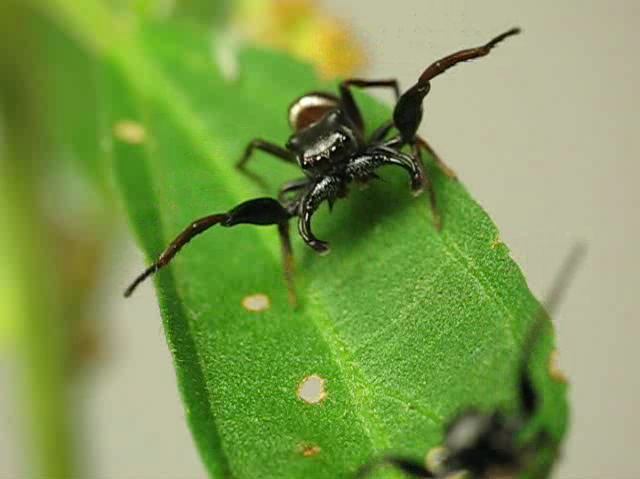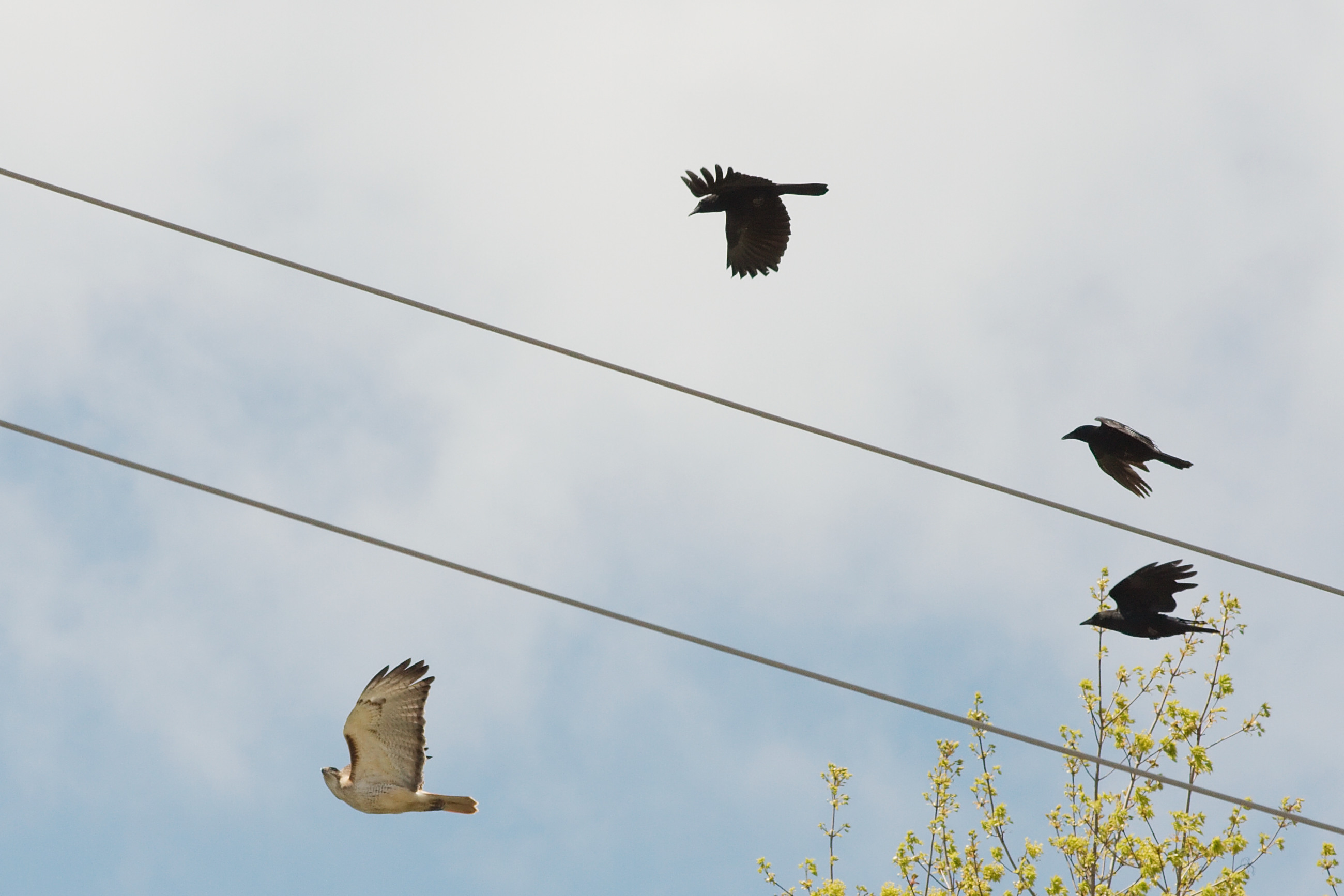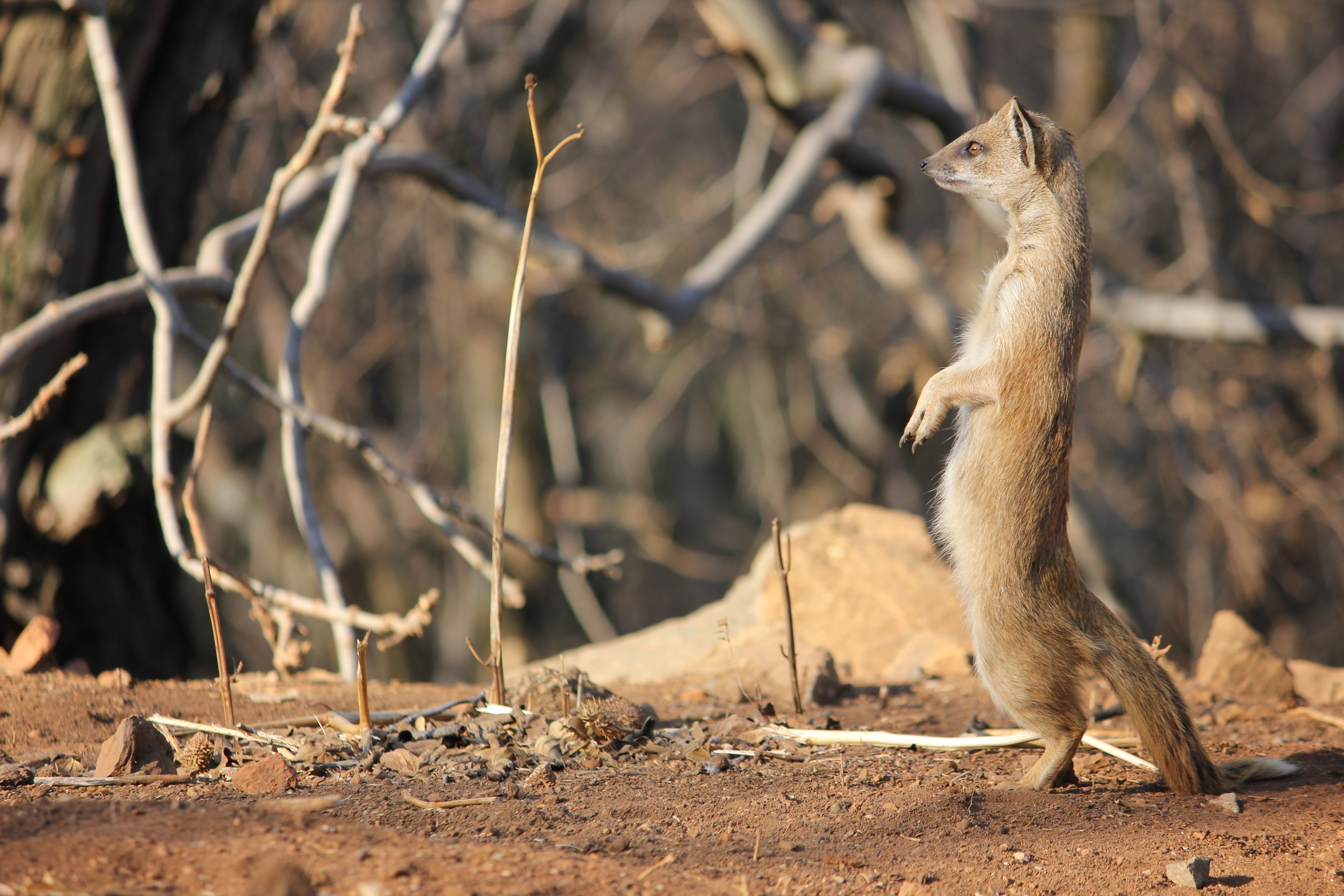|
Cape Ground Squirrel
The Cape ground squirrel or South African ground squirrel (''Geosciurus inauris'') is found in most of the drier parts of southern Africa from South Africa, through to Botswana, and into Namibia, including Etosha National Park. The name ''Cape'' ground squirrel is somewhat misleading as it actually has a much wider area of habitation. This common name may have been arrived at to distinguish it from a tree squirrel (the eastern grey squirrel) found around Cape Town, which was imported from Europe by Cecil John Rhodes. The species has also been known as the fan-tailed squirrel. Description The Cape ground squirrel has black skin with a coat made of short stiff hairs without underfur. The fur is cinnamon on the back while the face, underbelly, sides of neck and ventral sides of limbs are white.Skurski, D., J. Waterman. 2005. "Xerus inauris", ''Mammalian Species'' 781:1-4. The sides of its body each have a white stripe that stretches from the shoulders to the thighs. The eyes ... [...More Info...] [...Related Items...] OR: [Wikipedia] [Google] [Baidu] |
Krugersdorp Game Reserve
Krugersdorp Game Reserve is a 1500 Ha Game Reserve, located near the town of Krugersdorp, South Africa, approximately 40 minutes drive from central Johannesburg. It is a "small, intimate reserve that offers visitors a true African safari experience.... without the hassle of travelling to a major reserve houses 15 mammal species, including one of the “ Big Five”, while lions are kept in a special 100ha enclosure in the middle of the reserve. The reserve is also popular for bird watching Birdwatching, or birding, is the observing of birds, either as a recreational activity or as a form of citizen science. A birdwatcher may observe by using their naked eye, by using a visual enhancement device like binoculars or a telescope, by ..., and more than 200 species that have been recorded there; Guests can travel the park in vehicles or on horseback. Protected areas of Gauteng Mogale City Local Municipality ... [...More Info...] [...Related Items...] OR: [Wikipedia] [Google] [Baidu] |
Thermoregulation
Thermoregulation is the ability of an organism to keep its body temperature within certain boundaries, even when the surrounding temperature is very different. A thermoconforming organism, by contrast, simply adopts the surrounding temperature as its own body temperature, thus avoiding the need for internal thermoregulation. The internal thermoregulation process is one aspect of homeostasis: a state of dynamic stability in an organism's internal conditions, maintained far from thermal equilibrium with its environment (the study of such processes in zoology has been called physiological ecology). If the body is unable to maintain a normal temperature and it increases significantly above normal, a condition known as hyperthermia occurs. Humans may also experience lethal hyperthermia when the wet bulb temperature is sustained above for six hours. The opposite condition, when body temperature decreases below normal levels, is known as hypothermia. It results when the homeostatic c ... [...More Info...] [...Related Items...] OR: [Wikipedia] [Google] [Baidu] |
Sexually Transmitted Disease
Sexually transmitted infections (STIs), also referred to as sexually transmitted diseases (STDs) and the older term venereal diseases, are infections that are spread by sexual activity, especially vaginal intercourse, anal sex, and oral sex. STIs often do not initially cause symptoms, which results in a risk of passing the infection on to others. Symptoms and signs of STIs may include vaginal discharge, penile discharge, ulcers on or around the genitals, and pelvic pain. Some STIs can cause infertility. Bacterial STIs include chlamydia, gonorrhea, and syphilis. Viral STIs include genital herpes, HIV/AIDS, and genital warts. Parasitic STIs include trichomoniasis. STI diagnostic tests are usually easily available in the developed world, but they are often unavailable in the developing world. Some vaccinations may also decrease the risk of certain infections including hepatitis B and some types of HPV. Safe sex practices, such as use of condoms, having a smaller n ... [...More Info...] [...Related Items...] OR: [Wikipedia] [Google] [Baidu] |
Animal Sexual Behaviour
Animal sexual behaviour takes many different forms, including within the same species. Common mating or Reproduction, reproductively motivated systems include Monogamous pairing in animals, monogamy, Polygyny in animals, polygyny, Polyandry in nature, polyandry, polygamy and promiscuity. Other sexual behaviour may be reproductively motivated (e.g. Sexual coercion among animals, sex apparently due to duress or coercion and situational sexual behaviour) or Non-reproductive sexual behavior in animals, non-reproductively motivated (e.g. Homosexual behavior in animals, homosexual sexual behaviour, bisexuality, bisexual sexual behaviour, cross-species sex, Paraphilia, sexual arousal from objects or places, Necrophilia in animals, sex with dead animals, etc.). When animal sexual behaviour is reproductively motivated, it is often termed ''mating'' or ''Copulation (zoology), copulation''; for most non-human mammals, mating and copulation occur at Estrous cycle, oestrus (the most ferti ... [...More Info...] [...Related Items...] OR: [Wikipedia] [Google] [Baidu] |
Sperm Competition
Sperm competition is the competitive process between spermatozoa of two or more different males to fertilize the same egg during sexual reproduction. Competition can occur when females have multiple potential mating partners. Greater choice and variety of mates increases a female's chance to produce more viable offspring. However, multiple mates for a female means each individual male has decreased chances of producing offspring. Sperm competition is an evolutionary pressure on males, and has led to the development of adaptations to increase males' chance of reproductive success. Sperm competition results in a sexual conflict of interest between males and females. Males have evolved several defensive tactics including: mate-guarding, mating plugs, and releasing toxic seminal substances to reduce female re-mating tendencies to cope with sperm competition. Offensive tactics of sperm competition involve direct interference by one male on the reproductive success of another male, for ... [...More Info...] [...Related Items...] OR: [Wikipedia] [Google] [Baidu] |
Agonistic Behaviour
Agonistic behaviour is any social behaviour related to fighting. The term has broader meaning than aggressive behaviour because it includes threats, displays, retreats, placation, and conciliation. The term "agonistic behaviour" was first implemented by J.P Scott and Emil Fredericson in 1951 in their paper "The Causes of Fighting in Mice and Rats" in ''Physiological Zoology.'' wiktionary:agonistic, Agonistic behaviour is seen in many animal species because resources including food, shelter, and mates are often limited. Some forms of agonistic behaviour are between contestants who are competing for access to the same resources, such as food or mates. Other times, it involves tests of strength or threat display that make animals look large and more physically fit, a display that may allow it to gain the resource before an actual battle takes place. Although agonistic behaviour varies among species, agonistic interaction consists of three kinds of behaviours: #Threats, threat, #Agonis ... [...More Info...] [...Related Items...] OR: [Wikipedia] [Google] [Baidu] |
Estrus
The estrous cycle (, originally ) is the set of recurring physiological changes that are induced by reproductive hormones in most mammalian therian females. Estrous cycles start after sexual maturity in females and are interrupted by anestrous phases, otherwise known as "rest" phases, or by Pregnancy, pregnancies. Typically, estrous cycles repeat until death. These cycles are widely variable in duration and frequency depending on the species.Bronson, F. H., 1989. Mammalian Reproductive Biology. University of Chicago Press, Chicago, IL, USA. Some animals may display bloody vaginal discharge, often mistaken for menstruation. Many mammals used in commercial agriculture, such as cattle and sheep, may have their estrous cycles artificially controlled with hormonal medications for optimum productivity. The male equivalent, seen primarily in ruminants, is called Rut (mammalian reproduction), rut. Differences from the menstrual cycle Mammals share the same reproductive system, includ ... [...More Info...] [...Related Items...] OR: [Wikipedia] [Google] [Baidu] |
Ground Squirrels (Xerus Inauris) (7011271439)
Ground may refer to: Geology * Land, the surface of the Earth not covered by water * Soil, a mixture of clay, sand and organic matter present on the surface of the Earth Electricity * Ground (electricity), the reference point in an electrical circuit from which voltages are measured * Earthing system, part of an electrical installation that connects with the Earth's conductive surface * Ground and neutral, closely related terms Law * Ground (often grounds), in law, a rational motive or basis for a belief, conviction, or action taken, such as a legal action or argument: * Grounds for divorce, regulations specifying the circumstances under which a person will be granted a divorce Music * ''Ground'' (album), the second album by the Nels Cline Trio * "Ground" (song), one of the songs in the debut album of the Filipino rock band Rivermaya * Ground bass, in music, a bass part that continually repeats, while the melody and harmony over it change * ''The Ground'', a 2005 album by ... [...More Info...] [...Related Items...] OR: [Wikipedia] [Google] [Baidu] |
Mobbing (animal Behavior)
Mobbing in animals is an antipredator adaptation in which individuals of prey species mob a predator by cooperatively attacking or harassing it, usually to protect their offspring. A simple definition of mobbing is an assemblage of individuals around a potentially dangerous predator. This is most frequently seen in birds, though it is also known to occur in many other animals such as the meerkat and some bovines. While mobbing has evolved independently in many species, it only tends to be present in those whose young are frequently preyed upon. This behavior may complement cryptic adaptations in the offspring themselves, such as camouflage and hiding. Mobbing calls may be used to summon nearby individuals to cooperate in the attack. Konrad Lorenz, in his book ''On Aggression'' (1966), attributed mobbing among birds and animals to instincts rooted in the Darwinian struggle to survive. In his view, humans are subject to similar innate impulses but capable of bringing them under ... [...More Info...] [...Related Items...] OR: [Wikipedia] [Google] [Baidu] |
Commensalism
Commensalism is a long-term biological interaction (symbiosis) in which members of one species gain benefits while those of the other species neither benefit nor are harmed. This is in contrast with mutualism, in which both organisms benefit from each other; amensalism, where one is harmed while the other is unaffected; parasitism, where one is harmed and the other benefits, and parasitoidism, which is similar to parasitism but the parasitoid has a free-living state and instead of just harming its host, it eventually ends up killing it. The commensal (the species that benefits from the association) may obtain nutrients, shelter, support, or locomotion from the host species, which is substantially unaffected. The commensal relation is often between a larger host and a smaller commensal; the host organism is unmodified, whereas the commensal species may show great structural adaptation consistent with its habits, as in the remoras that ride attached to sharks and other fishes. Remo ... [...More Info...] [...Related Items...] OR: [Wikipedia] [Google] [Baidu] |
Mutualism (biology)
Mutualism describes the ecological interaction between two or more species where each species has a net benefit. Mutualism is a common type of ecological interaction. Prominent examples include most vascular plants engaged in mutualistic interactions with mycorrhizae, flowering plants being pollinated by animals, vascular plants being dispersed by animals, and corals with zooxanthellae, among many others. Mutualism can be contrasted with interspecific competition, in which each species experiences ''reduced'' fitness, and exploitation, or parasitism, in which one species benefits at the expense of the other. The term ''mutualism'' was introduced by Pierre-Joseph van Beneden in his 1876 book ''Animal Parasites and Messmates'' to mean "mutual aid among species". Mutualism is often conflated with two other types of ecological phenomena: cooperation and symbiosis. Cooperation most commonly refers to increases in fitness through within-species (intraspecific) interactions, althoug ... [...More Info...] [...Related Items...] OR: [Wikipedia] [Google] [Baidu] |
Yellow Mongoose
The yellow mongoose (''Cynictis penicillata''), sometimes referred to as the red meerkat, is a member of the mongoose family. It averages about in weight and about in length. It lives in open country, semi-desert scrubland and grasslands in Angola, Botswana, South Africa, Namibia, and Zimbabwe. It is the only species in the genus ''Cynictis''. Taxonomy ''Herpestes penicillatus'' was the scientific name proposed by Georges Cuvier in 1829 for a mongoose specimen from the Cape. The generic name ''Cynictis'' was proposed by William Ogilby in 1833 for a specimen collected in Kaffraria. ''Cynictis penicillata'' is the only member of the genus, but as many as twelve subspecies of yellow mongoose have been described. Characteristics In general, the yellow mongoose has lighter highlights on the underbelly and chin, a bushy tail, and a complete lack of sexual dimorphism. Southern yellow mongooses are larger, have yellow or reddish fur, longer fur, and a longer tail with a characte ... [...More Info...] [...Related Items...] OR: [Wikipedia] [Google] [Baidu] |
.jpg)






